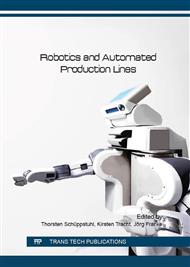[1]
T. Bauernhansl, M. ten Hompel, and B. Vogel-Heuser (Ed. ), Industrie 4. 0 in Produktion, Automatisierung und Logistik - Anwendung, Technologien, Migration, Springer, Berlin, (2014).
DOI: 10.1007/978-3-658-04682-8
Google Scholar
[2]
D. Kreimeier, E. Müller, F. Morlock, D. Jentsch, H. Unger, F. Börner and C. Block, Die synchrone Produktion, wt Werkstattstechnik online, 105 (2015) 4, p.204–208.
DOI: 10.37544/1436-4980-2015-04-46
Google Scholar
[3]
VDI 5600-1, Manufacturing Execution Systems (MES), Beuth, Berlin, (2007).
Google Scholar
[4]
J. Kletti, MES Manufacturing Execution System - Moderne Informationstechnologie zur Prozessfähigkeit der Wertschöpfung, Springer, Berlin, (2006).
DOI: 10.1007/978-3-662-46902-6
Google Scholar
[5]
VDI 4499-1, Digital factory – Fundamentals, Beuth, Berlin, (2008).
Google Scholar
[6]
VDI 4499-2, Digital factory – Digital Factory Operations, Beuth, Berlin, (2011).
Google Scholar
[7]
P. Göhner (Ed. ): Agentensysteme in der Automatisierungstechnik, Springer, Berlin, (2013).
Google Scholar
[8]
M. J. Wooldridge, An introduction to multiagent systems, John Wiley & Sons, Chichester, U.K., (2009).
Google Scholar
[9]
C. Block, F. Morlock, D. Kreimeier, and B. Kuhlenkötter, Intelligente Systemvernetzung durch Agentensysteme zur ganzheitlichen dezentralen Produktionsplanung und –steuerung, in: E. Müller (Ed. ), Planung und Betrieb von Produktionssystemen im digitalen Zeitalter - VPP 2015 - Vernetzt planen und produzieren, Wissenschaftliche Schriftenreihe des Instituts für Betriebswissenschaften und Fabriksysteme, Chemnitz, (2015).
DOI: 10.1007/978-3-662-06846-5_3
Google Scholar
[10]
S. Vernim and G. Reinhart, Production Planning and Control in Complex, Autonomous Systems - Acceptance by the Planner as Factor of Sucess for the Cooperation with such Systems, in J. P. Wulfsberg, B. Röhlig, and T. Montag (Eds. ), WGP Congress 2015 - Progress in Production Engineering, Trans Tech Publications, Pfaffikon, Switzerland, 2015, p.453.
DOI: 10.4028/www.scientific.net/amm.794.453
Google Scholar
[11]
H. Kagermann, Umsetzungsempfehlungen für das Zukunftsprojekt Industrie 4. 0 - Abschlussbericht des Arbeitskreises Industrie 4. 0, (2013).
Google Scholar
[12]
Bundesministerium für Bildung und Forschung (BMBF), Industrie 4. 0 - Innovationen für die Produktion von morgen, (2014).
Google Scholar
[13]
H. Hirsch-Kreinsen, Wandel von Produktionsarbeit – Industrie 4. 0, in: WSI-Mitteilungen, 6 (2014).
DOI: 10.5771/0342-300x-2014-6-421
Google Scholar
[14]
VDI 3633-1, Simulation of systems in materials handling, logistics and production – Fundamentals, Beuth, Berlin, (2014).
Google Scholar
[15]
VDI/VDE 2653-1, Multi-agent systems in industrial automation – Fundamentals, Beuth, Berlin, (2010).
Google Scholar
[16]
F. L. Bellifemine, G. Caire, and D. Greenwood, Wiley series in agent technology - Developing multi-agent systems with JADE, John Wiley, Chichester, England, Hoboken, NJ, (2007).
DOI: 10.1002/9780470058411
Google Scholar
[17]
S. Bergmann, Automatische Generierung adaptiver Modelle zur Simulation von Produktionssystemen, PhD Thesis, Ilmenau, (2013).
Google Scholar
[18]
Core Manufacturing Simulation Data ─ UML Model, SISO-STD-008-2010 - Approved standard.
Google Scholar
[19]
Core Manufacturing Simulation Data ─ XML Representation, SISO-STD-010-2012-DRAFT.
Google Scholar
[20]
K. Kravari and N. Bassiliades, A Survey of Agent Platforms, J. of Artificial Societies and Social Simulation, 18 (2015) 1.
DOI: 10.18564/jasss.2661
Google Scholar


